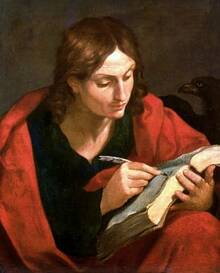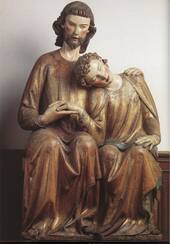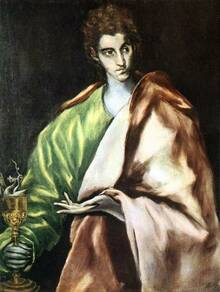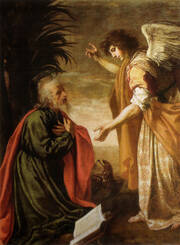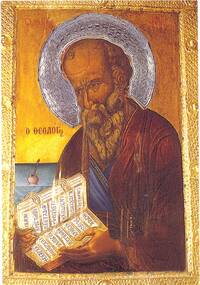Saint John, the Apostle and Evangelist
The youngest of the 12 Apostles; c AD 1 – c 100
Author of the Gospel of John, the three Epistles of John and the Book of Revelation, written on Patmos
Feast Day - 27th December
Pope Benedict XVI has given 3 catecheses on Saint John: John the son of Zebedee, John the theologian and John the Seer at Patmos.
3 2us by Father Francis Selman ![]()
St John was the youngest of the Apostles, 'the beloved disciple', the one whom Jesus loved and the only one of the 12 who remained with his Master all the way to the foot of the Cross. He was the last to write a Gospel and the last of the apostles to die as an old man, still the Bishop of Ephesus, around the year 100. With the wiritings of the last of the apostles, revelation came to a close. We keep his feast day just 2 days after the birth of our Saviour, when we think of the great mystery of the Incarnation, for St John was especially the Evangelist of the Incarnation. He wrote the phrase 'And the Word was made flesh', perhaps the most important sentence ever to have been written in history. I like to think that the reason why St John had a special insight into the mystery of the Incarnation was because he was the disciple to whom Jesus entrusted his mother at the foot of the Cross, "Behold your mother." Thus teaching us all to look to Mary as our mother and the mother of the Church."
Noelita, from England, chose St John as her Incredible Saint ![]()
"At the Last Supper, the idea of when St John rested his head on Jesus's breast, the idea of how he surrendered his intellect, almost his mind, to be absorbed completely next to Jesus's heart has always made me think how he surrendered his mind to his heart and to give his love completely to Jesus."
Christopher, from the UK also chose St John ![]()
"For me, John’s Gospel provides a window into understanding the love of Jesus and the Father, and their relationship. John the Evangelist was someone who would have known Jesus so intimately, who rested on his bosom at the Last Supper, got so close to listen to his words, that he became so effected by him that his words would have stayed with him his whole life and they can be found on the page of the Gospel in Jesus' long discourses, where we see the most beautiful love letters ever written between the Father and the Son."
Catechesis by Papa Benedict XVI 
1 (of 3) - John, son of Zebedee
Wednesday Audience, 5 July 2006 - in Croatian, English, French, German, Italian, Portuguese & Spanish
"Dear Brothers and Sisters,
We are dedicating today's meeting to the memory of another very important member of the apostolic college: John, son of Zebedee and brother of James. His typically Jewish name means: "the Lord has worked grace". He was mending his nets on the shore of Lake Tiberias, when Jesus called him together with his brother. John was always part of the small group that Jesus took with him on specific occasions. He was together with Peter and James when Jesus, at Capernaum, went into the home of Peter to cure his mother-in-law (cf Mk 1, 29); with the other two, he followed the Master into the house of Jairus, the head of the synagogue, whose daughter was to be brought back to life (cf Mk 5, 37); he followed Him when He climbed the mountain so as to be transfigured (cf Mk 9, 2); he was next to Him on the Mount of Olives when, in front of the immensity of Temple of Jerusalem, he gave the speech about the end of the city and of the world (cf Mk 13, 3); and, finally, he was close to the Master in the Garden of Gethsemane when he withdrew to pray to the Father before the Passion (cf Mk 14, 33). Shortly before the Passover, when Jesus chose two disciples to send them to prepare the room for the Supper, it was to John and Peter that he entrusted this task.
John's prominent position in the group of the Twelve makes somewhat understandable the initiative taken one day by his mother: she approached Jesus to ask him for her two sons, John and James, to be able to sit one on his right and one on his left in the Kingdom (cf Mt 20, 20-21). As we know, Jesus answered by in turn putting a question: he asked whether they were prepared to drink the chalice that he himself was about to drink (cf Mt 20, 22). The intention behind these words was to open the eyes of the two disciples, to introduce them to the knowledge of the mystery of his person and to refer their future calling to be his witnesses all the way to the supreme test of blood. Shortly after in fact Jesus explained that He had not come to be served but to serve and to give his life as a ransom for many (cf Mt 20, 28). In the days after the Resurrection, we find "the sons of Zebedee" busy with Peter and some of the other disciples on a fruitless night that, through the intervention of the Risen One, was followed by the miraculous catch: it was "the disciple Jesus loved" who recognized "the Lord" first and pointed him out to Peter (cf Jn 21, 1-13).
Within the Church of Jerusalem, John occupied a prominent place in directing the first group of Christians. Indeed, Paul lists him among those whom he calls the "pillars" of that community (cf Gal 2, 9). Luke presents him with Peter in Acts when they are going to pray in the Temple (cf Acts 3, 1-4) or appear before the Sanhedrin to witness to their faith in Jesus Christ (cf Acts 4, 13, 19). Together with Peter, he is sent by the Church of Jerusalem to confirm those who had accepted the Gospel in Samaria, praying for them to receive the Holy Spirit (cf Acts 8, 14-15). In particular, it must be remembered what together with Peter he affirmed before the Sanhedrin that was hearing their case: "We cannot but speak of what we have seen and heard" (Acts 4, 20). It is exactly this frankness in confessing his faith that is an example and an invitation to all of us to be always ready to declare with decision our steadfast adherence to Christ, putting faith before every calculation or human interest.
According to tradition, John is the "beloved disciple", who in the Fourth Gospel lays his head on the Master's breast during the Last Supper (cf Jn 13, 21), stands at the foot of the Cross together with the Mother of Jesus (cf Jn 19, 25) and lastly is witness both of the empty tomb and of the very presence of the Risen One (cf Jn 20, 2; 21, 7). We know that this identification is disputed by scholars today, some of whom view him merely as the prototype of a disciple of Jesus. Leaving the exegetes to settle the matter, let us be content here to gather an important lesson for our lives: the Lord desires to make each one of us a disciple who lives a personal friendship with Him. To realise this, it is not enough to follow him and to listen to him exteriorly: it is also necessary to live with Him and like Him. This is possible only in the context of a rapport of great familiarity, imbued with the warmth of total trust. This is what happens between friends; this is why Jesus said one day: "No one has a greater love than this: to give his life for his friends.... I no longer call you servants, for a servant does not know what his master is doing; but I have called you friends, for all that I have heard from my Father I have made known to you" (Jn 15, 13. 15).
In the apocryphal Acts of John, the Apostle is presented not as the founder of Churches nor as the guide of already established communities, but in continual journeying as the communicator of faith in the encounter with "souls capable of hoping and of being saved" (18, 10; 23, 8). Everything is motivated by the paradoxical intention of making the invisible seen. And indeed he is called simply "the Theologian" by the Eastern Church, that is, the one who is able to speak of divine things in accessible terms, by revealing an arcane access to God through adherence to Jesus.
The cult of the Apostle John was affirmed starting from the city of Ephesus where, according to an ancient tradition, he worked for a long time, dying in the end at an extraordinarily advanced age, during the reign of the Emperor Trajan. In Ephesus, the Emperor Justinian had a great basilica built in the 6th century in his honour, of which there are still impressive ruins. Precisely in the East, he enjoyed and still enjoys great veneration. In Byzantine iconography he is often depicted as very elderly - according to tradition, he died under the Emperor Trajan - and in the act of intense contemplation, almost in an attitude of one who is inviting silence.
Indeed, without sufficient recollection it is not possible to approach the supreme mystery of God and his revelation. This explains why, years ago, the Ecumenical Patriarch of Constantinople, Athenagoras, whom Pope Paul VI embraced at a memorable encounter, affirmed: "John is at the origin of our highest spirituality. Like him, the 'silent ones' know this mysterious exchange of hearts, they invoke John's presence and their hearts are set on fire" (O. Clément, Dialogues with Athenagoras, Turin 1972, p 159). May the Lord help us to put ourselves at the school of John so as to learn the great lesson of love in a way that we feel loved by Christ "to the very end" (Jn 13, 1), and give our lives for Him."
Catechesis by Papa Benedict:
John, the theologian
(2 of 3) - in Croatian, English, French, German, Italian, Portuguese & Spanish
"Dear brothers and sisters,
Before the holidays I had started the small portraits of the twelve Apostles. The Apostles were the travelling companions of Jesus, the friends of Jesus and their journey with Jesus was not only a exterior pathway/exterior journey, from Galilee to Jerusalem, but an interior pathway/journey on which they learned faith in Jesus Christ, not without difficulty because they were men like us. But exactly for this/for this very reason, because they were Jesus' travelling companions, Jesus' friends, who on a pathway/journey that was not easy learnt (the) faith, they are also guides for us, who help us to know Jesus Christ, to love Him and to have faith in Him. I have already spoken about four of the twelve Apostles: Simon Peter, his brother Andrew, James the brother of Saint John, and the other James, called "the Less", who wrote a Letter that we find in the New Testament. And I had started to speak about John the Evangelist, gathering together in the last catechesis before the holidays the essential facts that delineate/outline of his physiognomy. I would now like to concentrate/focus attention on the content of his teaching. His writings that we want to examine today, therefore, are the Gospel and the Letters that go under his name.
I would now like to focus attention on the content of his teaching. The writings that we want to examine today, therefore, are the Gospel and the Letters that go under his name.
If there is one characteristic topic that emerges from John's writings, it is love. It is not by chance that I wanted to begin my first Encyclical Letter with this Apostle's words, "God is love (Deus caritas est); he who abides in love abides in God, and God abides in him" (I Jn 4: 16). It is very difficult to find texts of this kind in other religions. Thus, words such as these bring us face to face with an element that is truly peculiar to Christianity. John, of course, is not the only author of Christian origin to speak of love. Since this is an essential constituent of Christianity, all the New Testament writers speak of it, although with different emphases. If we are now pausing to reflect on this subject in John, it is because he has outlined its principal features insistently and incisively. We therefore trust his words. One thing is certain: he does not provide an abstract, philosophical or even theological treatment of what love is. No, he is not a theoretician. True love, in fact, by its nature is never purely speculative but makes a direct, concrete and even verifiable reference to real persons. Well, John, as an Apostle and a friend of Jesus, makes us see what its components are, or rather, the phases of Christian love, a movement marked by three moments.
The first concerns the very Source of love which the Apostle identifies as God, arriving at the affirmation that "God is love" (I Jn 4: 8, 16). John is the only New Testament author who gives us definitions of God. He says, for example, that "God is spirit" (Jn 4: 24) or that "God is light" (I Jn 1: 5). Here he proclaims with radiant insight that "God is love". Take note: it is not merely asserted that "God loves", or even less that "love is God"! In other words: John does not limit himself to describing the divine action but goes to its roots. Moreover, he does not intend to attribute a divine quality to a generic and even impersonal love; he does not rise from love to God, but turns directly to God to define his nature with the infinite dimension of love. By so doing, John wants to say that the essential constituent of God is love and hence, that all God's activity is born from love and impressed with love: all that God does, he does out of love and with love, even if we are not always immediately able to understand that this is love, true love.
At this point, however, it is indispensable to take another step and explain that God has concretely demonstrated his love by entering human history through the Person of Jesus Christ, incarnate, dead and risen for us. This is the second constitutive moment of God's love. He did not limit himself to verbal declarations but, we can say, truly committed himself and "paid" in the first person. Exactly as John writes, "God so loved the world", that is, all of us, "that he gave his only Son" (Jn 3: 16). Henceforth, God's love for humanity is concretized and manifested in the love of Jesus himself. Again, John writes: "Having loved his own who were in the world, he loved them to the end" (Jn 13: 1). By virtue of this oblative and total love we are radically ransomed from sin, as St John writes further: "My little children... if any one does sin, we have an advocate with the Father, Jesus Christ, the righteous; and he is the expiation for our sins, and not for ours only but also for the sins of the whole world" (I Jn 2: 1-2; cf. I Jn 1: 7). This is how Jesus' love for us reaches us: by the pouring out of his own Blood for our salvation! The Christian, pausing in contemplation before this "excess" of love, cannot but wonder what the proper response is. And I think each one of us, always and over and over again, must ask himself or herself this.
This question introduces us into the third moment of the dynamic of love: from being the recipients of a love that precedes and surpasses us, we are called to the commitment of an active response which, to be adequate, can only be a response of love. John speaks of a "commandment". He is, in fact, referring to these words of Jesus: "A new commandment I give to you, that you love one another; even as I have loved you, that you also love one another" (Jn 13: 34). Where is the newness to which Jesus refers? It lies in the fact that he is not content with repeating what had already been requested in the Old Testament and which we also read in the other Gospels: "You shall love your neighbour as yourself" (Lv 19: 18; cf. Mt 22: 37-39; Mk 12: 29-31; Lk 10: 27). In the ancient precept the standard criterion was based on man ("as yourself"), whereas in the precept to which John refers, Jesus presents his own Person as the reason for and norm of our love: "as I have loved you". It is in this way that love becomes truly Christian: both in the sense that it must be directed to all without distinction, and above all since it must be carried through to its extreme consequences, having no other bounds than being boundless. Those words of Jesus, "as I have loved you", simultaneously invite and disturb us; they are a Christological goal that can appear unattainable, but at the same time they are an incentive that does not allow us to ensconce ourselves in what we have been able to achieve. It does not permit us to be content with what we are but spurs us to keep advancing towards this goal.
In The Imitation of Christ, that golden text of spirituality which is the small book dating back to the late Middle Ages, on this subject is written: "The love of Jesus is noble and generous: it spurs us on to do great things, and excites us to desire always that which is most perfect. Love will tend upwards and is not to be detained by things beneath. Love will be at liberty and free from all worldly affections... for love proceeds from God and cannot rest but in God above all things created. The lover flies, runs and rejoices, he is free and not held. He gives all for all and has all in all, because he rests in one sovereign good above all, from whom all good flows and proceeds" (Thomas à Kempis, The Imitation of Christ, Book III, Chapter V, 3-4). What better comment could there be on the "new commandment" spelled out by John? Let us pray to the Father to be able, even if always imperfectly, to live it so intensely that we share it with those we meet on our way."
Catechesis by Papa Benedict:
John, the Seer of Patmos
(3 of 3) - in Croatian, English, French, German, Italian, Portuguese & Spanish
"In the last catechesis we had reached the meditation on the figure of the Apostle John. We had first sought to look at all that can be known of his life. Then, in a 2nd Catechesis, we meditated on the central content of his Gospel and his Letters: charity, love. And today we are still concerned with the figure of John, this time to examine the Seer of the Book of Revelation. And let us immediately note that while neither the Fourth Gospel nor the Letters attributed to the Apostle ever bear his name, the Book of Revelation makes at least 4 references to it. It is obvious, on the one hand, that the author had no reason not to mention his own name, and on the other, that he knew his first readers would be able to precisely identify him. We know, moreover, that in the third century, scholars were already disputing the true factual identity of John of the "Apocalypse". For the sake of convenience we could also call him "the Seer of Patmos" because he is linked to the name of this island in the Aegean See where, according to his own autobiographical account, he was, as it were, deported "on account of the word of God and the testimony of Jesus" (Rv 1: 9). It was on Patmos itself, "on the Lord's Day... caught up in ecstasy" (Rv 1: 10), that John had a grandiose vision and heard extraordinary messages that were to have a strong influence on the history of the Church and of entire Western culture. For example, from the title of his book - Apocalypse, Revelation - the words "apocalypse, apocalyptic" were introduced into our language and, although inaccurately, they call to mind the idea of an incumbent catastrophe.
The Book should be understood against the backdrop of the dramatic experiences of the 7 Churches of Asia (Ephesus, Smyrna, Pergamum, Thyatira, Sardis, Philadelphia, Laodicea) which had to face serious difficulties at the end of the 1st century - persecutions and also inner tensions - in their witness to Christ. John addresses them, showing acute pastoral sensitivity to the persecuted Christians, whom he exhorts to be steadfast in the faith and not to identify with the pagan world. His purpose is constituted once and for all by the revelation, starting with the death and Resurrection of Christ, of the meaning of human history. The first and fundamental vision of John, in fact, concerns the figure of the Lamb who is slain yet standing (cf. Rv 5: 6), and is placed before the throne on which God himself is already seated. By saying this, John wants first of all to tell us two things: the first is that although Jesus was killed with an act of violence, instead of falling heavily to the ground, he paradoxically stands very firmly on his own feet because, with the Resurrection, he overcame death once and for all. The other thing is that Jesus himself, precisely because he died and was raised, henceforth fully shares in the kingship and saving power of the Father. This is the fundamental vision. On this earth, Jesus, the Son of God, is a defenceless, wounded and dead Lamb. Yet he stands up straight, on his feet, before God's throne and shares in the divine power. He has the history of the world in his hands. Thus, the Seer wants to tell us: trust in Jesus, do not be afraid of the opposing powers, of persecution! The wounded and dead Lamb is victorious! Follow the Lamb Jesus, entrust yourselves to Jesus, take his path! Even if in this world he is only a Lamb who appears weak, it is he who triumphs!
The subject of one of the most important visions of the Book of Revelation is this Lamb in the act of opening a scroll, previously closed with seven seals that no one had been able to break open. John is even shown in tears, for he finds no one worthy of opening the scroll or reading it (cf. Rv 5: 4). History remains indecipherable, incomprehensible. No one can read it. Perhaps John's weeping before the mystery of a history so obscure expresses the Asian Churches' dismay at God's silence in the face of the persecutions to which they were exposed at that time. It is a dismay that can clearly mirror our consternation in the face of the serious difficulties, misunderstandings and hostility that the Church also suffers today in various parts of the world. These are trials that the Church does not of course deserve, just as Jesus himself did not deserve his torture. However, they reveal both the wickedness of man, when he abandons himself to the promptings of evil, and also the superior ordering of events on God's part. Well then, only the sacrificed Lamb can open the sealed scroll and reveal its content, give meaning to this history that so often seems senseless. He alone can draw from it instructions and teachings for the life of Christians, to whom his victory over death brings the message and guarantee of victory that they too will undoubtedly obtain. The whole of the vividly imaginative language that John uses aims to offer this consolation.
Also at the heart of the visions that the Book of Revelation unfolds, are the deeply significant vision of the Woman bringing forth a male child and the complementary one of the dragon, already thrown down from Heaven but still very powerful. This Woman represents Mary, the Mother of the Redeemer, but at the same time she also represents the whole Church, the People of God of all times, the Church which in all ages, with great suffering, brings forth Christ ever anew. And she is always threatened by the dragon's power. She appears defenceless and weak. But while she is threatened, persecuted by the dragon, she is also protected by God's comfort. And in the end this Woman wins. The dragon does not win. This is the great prophecy of this Book that inspires confidence in us! The Woman who suffers in history, the Church which is persecuted, appears in the end as the radiant Bride, the figure of the new Jerusalem where there will be no more mourning or weeping, an image of the world transformed, of the new world whose light is God himself, whose lamp is the Lamb.
For this reason, although John's Book of Revelation is pervaded by continuous references to suffering, tribulation and tears - the dark face of history -, it is likewise permeated by frequent songs of praise that symbolize, as it were, the luminous face of history. So it is, for example, that we read in it of a great multitude that is singing, almost shouting: "Alleluia! For the Lord our God the Almighty reigns. Let us rejoice and exult and give him the glory, for the marriage of the Lamb has come, and his Bride has made herself ready" (Rv 19: 6-7). Here we face the typical Christian paradox, according to which suffering is never seen as the last word but rather, as a transition towards happiness; indeed, suffering itself is already mysteriously mingled with the joy that flows from hope. For this very reason John, the Seer of Patmos, can close his Book with a final aspiration, trembling with fearful expectation. He invokes the definitive coming of the Lord: "Come, Lord Jesus!" (Rv 22: 20). This was one of the central prayers of the nascent Christianity, also translated by St Paul into its Aramaic form: "Marana tha". And this prayer, "Our Lord, come!" (I Cor 16: 22) has many dimensions. It is, naturally, first and foremost an expectation of the definitive victory of the Lord, of the new Jerusalem, of the Lord who comes and transforms the world. But at the same time, it is also a Eucharistic prayer: "Come Jesus, now!". And Jesus comes; he anticipates his definitive coming. So it is that we say joyfully at the same time: "Come now and come for ever!". This prayer also has a third meaning: "You have already come, Lord! We are sure of your presence among us. It is our joyous experience. But come definitively!". And thus, let us too pray with St Paul, with the Seer of Patmos, with the newborn Christianity: "Come, Jesus! Come and transform the world! Come today already and may peace triumph!". Amen!"
BXVI - General Audiences - 5 July, 9 & 23 August 2006 - © Copyright 2006 - Libreria Editrice Vaticana
Rupert of Deutz, in The Works of the Holy Spirit (IV, 10; SC 165)"
In proportion to the grace that caused Jesus to love him and enabled him to rest on Jesus' breast at the Supper (Jn 13,23), John abundantly received [the Spirit's gifts] of understanding and wisdom (Is 11,2) – understanding with which to comprehend Scripture, wisdom with which to compose his own books with wonderful skill. As a matter of fact he did not receive this gift right from the time when he rested on our Lord's breast, even if he was subsequently able to draw from that heart “in which are hidden all the treasures of wisdom and knowledge” (Col 2,3). When he says that when he went into the tomb “he saw and he believed”, he acknowledges that “they did not yet understand the Scripture that Jesus had to rise from the dead” (Jn 20,9). Like all the other apostles, John received its fulness when the Holy Spirit came [at Pentecost] and when grace had been given to each of them “according to the measure of Christ's gift” (Eph 4,7)...
The Lord Jesus loved this disciple more than all the others... and opened the secrets of heaven to him... to make of him the author of that profound mystery man can say nothing about of himself: the mystery of the Word, God's Utterance, the Word made flesh. This is the fruit of that love. Yet even though he loved him it was not to him that Jesus said: “You are Peter, and on this rock I shall build my Church” (Mt 16,18)... While he loved all his disciples, and especially Peter, with a love in mind and soul, our Lord loved John with the love of his heart... In the order of apostleship Simon Peter received the first place and the “keys of the Kingdom of heaven” (Mt 16,19); but John won another inheritance: the spirit of understanding, “a wealth of joy and gladness” (Sir 15,6).

